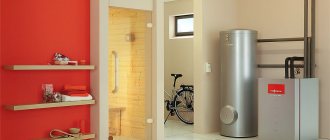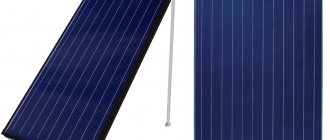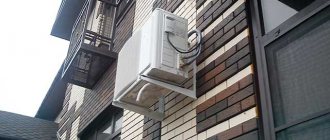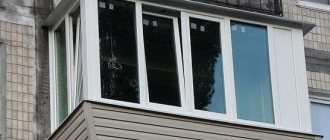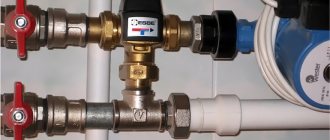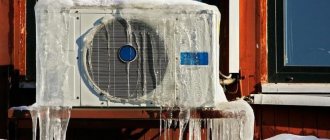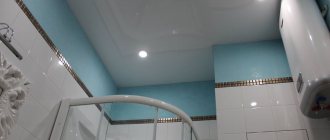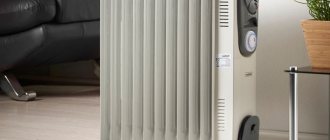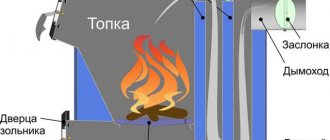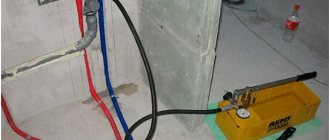The principle of operation of a split system with forced ventilation
The air conditioner consists of two blocks:
- indoor unit including filter, fan, cooler and electronic control panel
- outdoor unit, including a compressor-condensing unit with a heat pump and a microprocessor control module
The indoor unit is installed on the wall (wall-mounted split system) or behind a suspended ceiling or in a box (ducted split system), while the interior design is not disrupted because all equipment is mounted behind the suspended ceiling. Only elegant decorative grilles for air supply remain in the interior.
The outdoor unit can be installed outdoors or indoors (if the unit is equipped with a centrifugal fan). They are connected by a thin freon pipeline. An electric or water heater with electronic control is connected to the indoor unit.
Fresh air is taken from the street and supplied through a thermally insulated air duct into the mixing chamber, where it is mixed with air from the room. Then the air mixture is filtered and processed in the indoor unit depending on the specified mode (cooled, dehumidified or heated). It is then distributed throughout the premises.
“Standard Climate” is a professional climate control company, ready to implement turnkey solutions to any problems regarding climate control and other engineering equipment. We will carry out a full cycle of work: selection of equipment, design, installation, delivery and maintenance. You can submit an application on the website airclimat.ru. Call now: +7(499) 350-94-14
. Submit your application
Types of duct air conditioners
ducted air conditioning system
All manufacturers produce models that operate either cold only or cold/heat. Duct air conditioners with a mixture of fresh air can be with inverter or non-inverter type of compressor control. These split systems differ not only in cooling capacity, but also in blowing power, that is, the pressure of the outgoing flow. There are low-pressure, medium-pressure and high-pressure duct air conditioners. The selection of the length and configuration of the air ducts depends on the force of pressure (static pressure) created by the fan.
Low pressure air conditioners
This air conditioner has a maximum static pressure of 45 Pa. It can process air in one room, and the length of the ventilation piping is no more than a meter. Low-pressure models are installed in hotel rooms, small offices and apartments.
Medium pressure air conditioners
For medium-pressure systems, the pressure force can reach up to 100 Pa, and the total length of the air ducts is measured in tens of meters. They are considered the most popular, as they best satisfy the needs of apartments with several rooms, small cottages, cafes, medium-sized offices and shops.
High-pressure air conditioners
high-pressure duct air conditioner MITSUBISHI HEAVY
The pressure force of such models is up to 250 Pa. The length of air ducts can exceed a hundred meters, and their configuration can be complex and highly branched. They install high-pressure ducted air conditioners in large offices, conference rooms, large restaurants and residential buildings with many rooms.
To remove condensate accumulated during operation of the device, a high-pressure duct air conditioner is usually equipped with an additional drain pump. These devices have the highest performance compared to low- and medium-pressure ones. All of the listed characteristics help distribute air even to remote rooms without any losses and in full.
Microprocessor control system
The electronic control system automatically maintains the required parameters of the air conditioning and ventilation system at any time of the year. In summer, the air is cooled and the room is maintained at the set temperature. In autumn and spring, the air conditioner switches to “heat pump” mode and effectively heats the air without turning on air heaters (electric or water). If the outside temperature drops below 0C, an additional heater (duct-type air conditioner) is turned on. The electronic heater control module allows you to smoothly regulate its power depending on the outside air temperature, which ensures minimal power consumption.
Are household appliances capable of supplying air from the street?
To bring cooled fresh air into the room, a new generation of devices has appeared - air conditioners. These include:
some models of Panasonic air conditioners that have a special membrane in the unit. It allows you to maintain a constant flow of oxygen;- the well-known brand Mitsubishi Electric has put up for sale a system that, in addition to supply ventilation, has additional filtration;
- climate market leader Daikin has released models with humidification and air flow;
- Hitachi has similar developments, but so far in models with low productivity.
They differ from classic “splits” by the presence of an additional air duct (hose) , which is equipped with various devices for regulating the air supply.
Membrane
The operation of the air duct is regulated by a special membrane, which is “responsible” for the throughput. The required level of oxygen is maintained in the room due to its better penetration than particles of other gases.
Modular system
It is an addition to the one already installed in the form of a module, which is a small hood with a fresh air supply. This option has little air exchange and large dimensions, which is a disadvantage.
Conclusion: If you have EXTRA money, then of course you can pay attention to split systems with air supply. But I believe that this option will not have the effect of full ventilation. When choosing an air conditioner for your home or office, traditional “splits” are quite suitable (read a separate article on how to choose them). Nobody canceled the periodic opening of the window for ventilation. Well, if we talk about an industrial or commercial premises, then a separate ventilation system and a separate air conditioning system will definitely be required!
That's all! Good luck!
The main advantages of a split system with forced ventilation
1. Fresh air - all year round
One of the main advantages of an air conditioning and ventilation system is a stable supply of fresh air at any time of the year. Thanks to a system of built-in air heaters with electronic control, in winter the fresh supply air is heated to the temperature you need. A unique engineering solution allows the equipment to operate efficiently at low subzero temperatures.
2. Thorough air purification
If you live or work in the city center or next to a busy road, then the problem arises of cleaning the air coming from the street. Air conditioners are equipped with reusable class filters (EU-3). These filters allow you to clean the incoming air. In addition, the filters are easy to clean and last a long time. Clean, fresh air enters your premises all year round.
3. Simultaneous operation
The equipment of the air conditioning and ventilation system allows you to condition and supply fresh air to several rooms simultaneously. Our engineers will carefully study your premises and select a system that can not only create a comfortable climate, but also ensure the supply of the required amount of fresh air for each person.
4. Easy to control
A powerful microprocessor controls the operation of the heater, external and internal air conditioner units. It analyzes the temperature outside, indoors and the temperature you set on the control panel. After this, the system itself selects the optimal operating mode for all units. Fresh air is automatically heated or cooled. You just set the fan speed and the desired room temperature on the control panel. Automation does the rest for you.
5.Low noise
The air conditioner is installed on the wall (wall-mounted air conditioner), or behind a suspended ceiling or in a box (ducted air conditioner) in residential and office premises. Silent operation of the duct unit is achieved by using specially selected materials that absorb sound and vibration. In addition, special soundproofed air ducts are used when installing the system.
Mixing is carried out using an external block connected to the internal block with a flexible hose. The supplied air is filtered.
About supply ventilation:
What kind of air does the air conditioner blow?
“The air conditioner blows air that it takes from the street.” This is a common misconception. Perhaps we can start this article with these words. Every second client believes that since the air conditioner has an external unit outside the window, the air conditioner itself takes fresh air and supplies it to the room. If you were present during the installation of the air conditioner, you could observe that a route is extended to the external unit from the internal one, which consists of:
- copper gas and liquid tube for freon;
- a tube for drainage (when condensate is discharged outside);
- interconnect control and power cable.
As you can see, when installing an air conditioner, no air ducts are laid that can supply atmospheric air to the room. In other words, the air conditioner passes room air through the indoor unit, which is cooled by passing through a thin plate heat exchanger.
Communications to the external unit only serve to remove heat, and not to supply air from the street to the room. A split system is not a ventilation unit!
In the external block, freon is compressed by a compressor, the condenser is blown by a fan to remove excess heat, and the already liquid freon is supplied to the indoor block to evaporate and cool the room.
But there are exceptions! And more about them below.
Service
For normal operation of the device, proper maintenance is required. Among the main manipulations:
- Removing dirt from the condensate tank. You also need to check the tubes, treating them with a disinfectant solution, to avoid the appearance of pathogenic bacteria.
- Refrigerant pressure control.
- Elimination of dust from air ducts.
- Cleaning the duct air conditioner in the filter part.
If you ignore these measures, the volume of passing air will be reduced, and the unit will not be able to maintain the temperature set by the consumer. In addition, the device may simply break or leak in the indoor unit. The price of a duct air conditioner is not so small that you risk its serviceability by neglecting basic operating rules. The frequency of preventive and maintenance work is indicated in the instructions for use.
Advantages and disadvantages
As we have already found out, supply air conditioners are superior to conventional ones, and their main advantage is to create a healthy atmosphere in the refrigerated room. However, this variety has several additional advantages:
- the flow of fresh air is ensured at any time of the year, regardless of the temperature;
- the cleaning function allows you to receive oxygen without dust and impurities, which can be very useful in large and noisy cities;
- the microprocessor automatically maintains the set temperature and humidity level in the room, and clear controls make it easy to adjust these settings.
Of course, there were some drawbacks too:
- many models make too much noise due to the presence of an additional fan, so the indicators are on the verge of 30 dB, which, according to the law, cannot be exceeded at night;
- supply air conditioners are not capable of completely replacing a full-fledged ventilation system;
- higher cost when compared with conventional air conditioners.
